Elasticity of Fuel in Malaysia
VerifiedAdded on 2023/03/31
|8
|1731
|134
AI Summary
This article discusses the elasticity of demand and supply for fuel in Malaysia. It explores the concept of inelastic demand and its impact on the market. The article also examines the factors affecting the demand for fuel and the implications for the Malaysian economy.
Contribute Materials
Your contribution can guide someone’s learning journey. Share your
documents today.
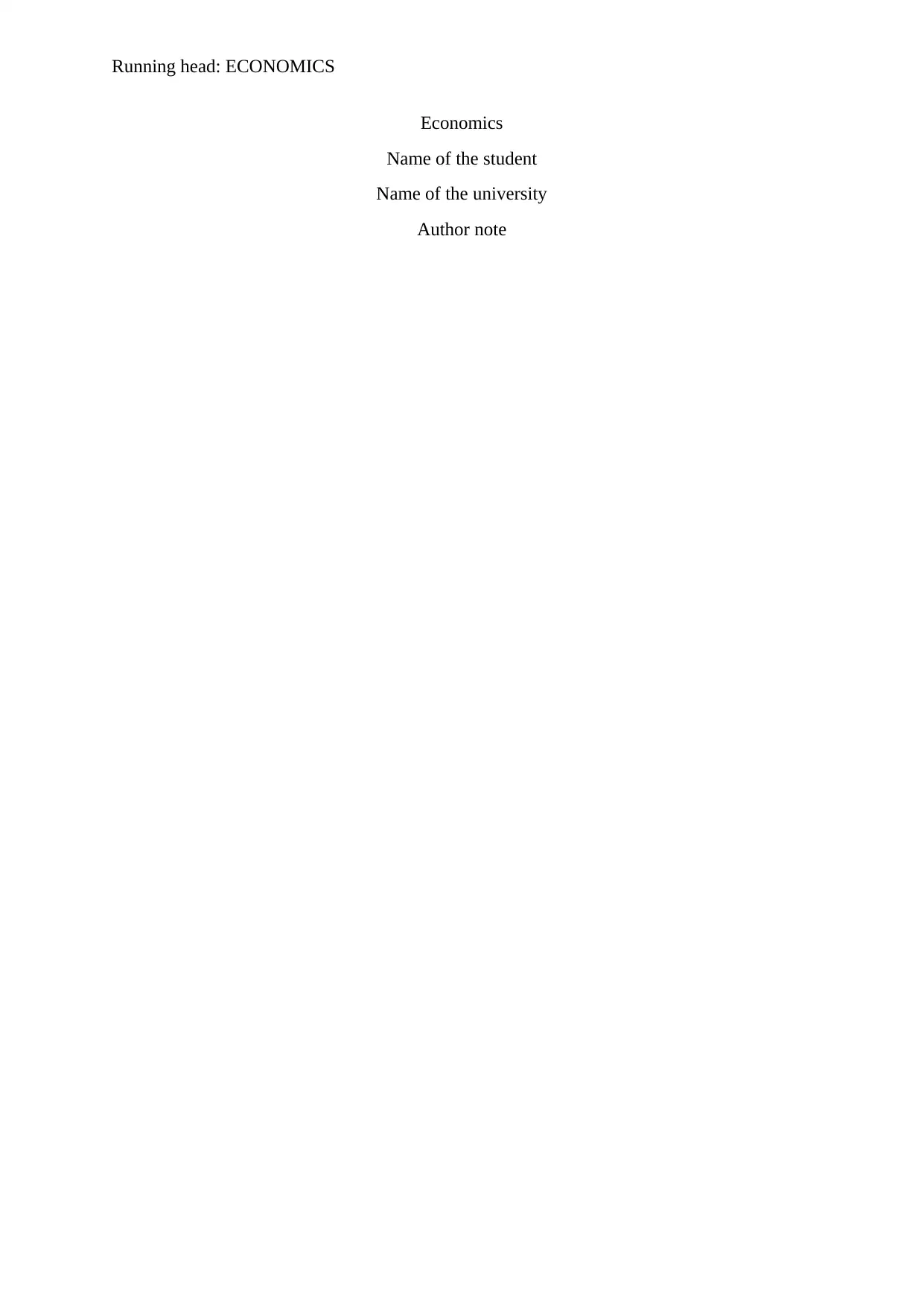
Running head: ECONOMICS
Economics
Name of the student
Name of the university
Author note
Economics
Name of the student
Name of the university
Author note
Secure Best Marks with AI Grader
Need help grading? Try our AI Grader for instant feedback on your assignments.
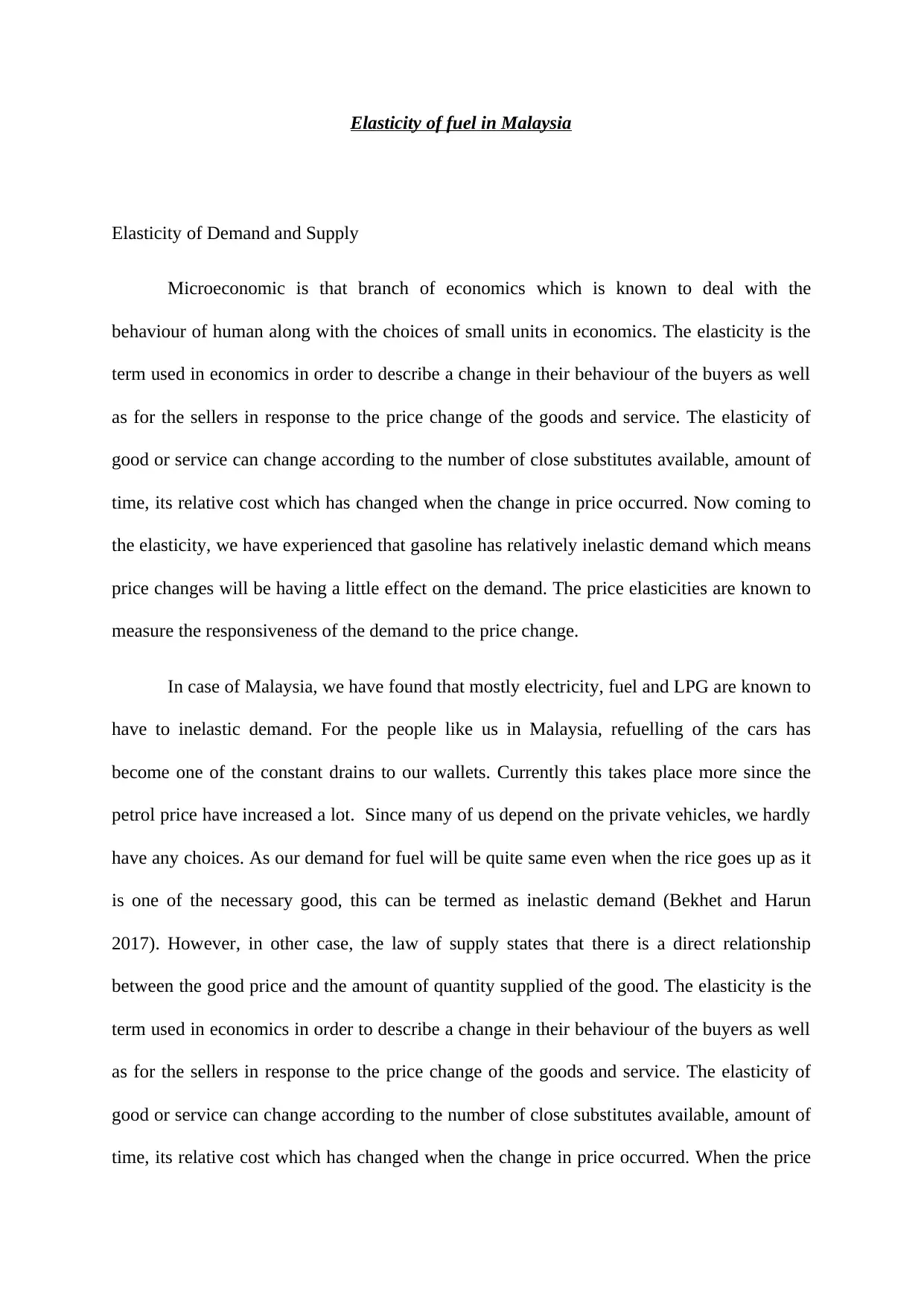
Elasticity of fuel in Malaysia
Elasticity of Demand and Supply
Microeconomic is that branch of economics which is known to deal with the
behaviour of human along with the choices of small units in economics. The elasticity is the
term used in economics in order to describe a change in their behaviour of the buyers as well
as for the sellers in response to the price change of the goods and service. The elasticity of
good or service can change according to the number of close substitutes available, amount of
time, its relative cost which has changed when the change in price occurred. Now coming to
the elasticity, we have experienced that gasoline has relatively inelastic demand which means
price changes will be having a little effect on the demand. The price elasticities are known to
measure the responsiveness of the demand to the price change.
In case of Malaysia, we have found that mostly electricity, fuel and LPG are known to
have to inelastic demand. For the people like us in Malaysia, refuelling of the cars has
become one of the constant drains to our wallets. Currently this takes place more since the
petrol price have increased a lot. Since many of us depend on the private vehicles, we hardly
have any choices. As our demand for fuel will be quite same even when the rice goes up as it
is one of the necessary good, this can be termed as inelastic demand (Bekhet and Harun
2017). However, in other case, the law of supply states that there is a direct relationship
between the good price and the amount of quantity supplied of the good. The elasticity is the
term used in economics in order to describe a change in their behaviour of the buyers as well
as for the sellers in response to the price change of the goods and service. The elasticity of
good or service can change according to the number of close substitutes available, amount of
time, its relative cost which has changed when the change in price occurred. When the price
Elasticity of Demand and Supply
Microeconomic is that branch of economics which is known to deal with the
behaviour of human along with the choices of small units in economics. The elasticity is the
term used in economics in order to describe a change in their behaviour of the buyers as well
as for the sellers in response to the price change of the goods and service. The elasticity of
good or service can change according to the number of close substitutes available, amount of
time, its relative cost which has changed when the change in price occurred. Now coming to
the elasticity, we have experienced that gasoline has relatively inelastic demand which means
price changes will be having a little effect on the demand. The price elasticities are known to
measure the responsiveness of the demand to the price change.
In case of Malaysia, we have found that mostly electricity, fuel and LPG are known to
have to inelastic demand. For the people like us in Malaysia, refuelling of the cars has
become one of the constant drains to our wallets. Currently this takes place more since the
petrol price have increased a lot. Since many of us depend on the private vehicles, we hardly
have any choices. As our demand for fuel will be quite same even when the rice goes up as it
is one of the necessary good, this can be termed as inelastic demand (Bekhet and Harun
2017). However, in other case, the law of supply states that there is a direct relationship
between the good price and the amount of quantity supplied of the good. The elasticity is the
term used in economics in order to describe a change in their behaviour of the buyers as well
as for the sellers in response to the price change of the goods and service. The elasticity of
good or service can change according to the number of close substitutes available, amount of
time, its relative cost which has changed when the change in price occurred. When the price
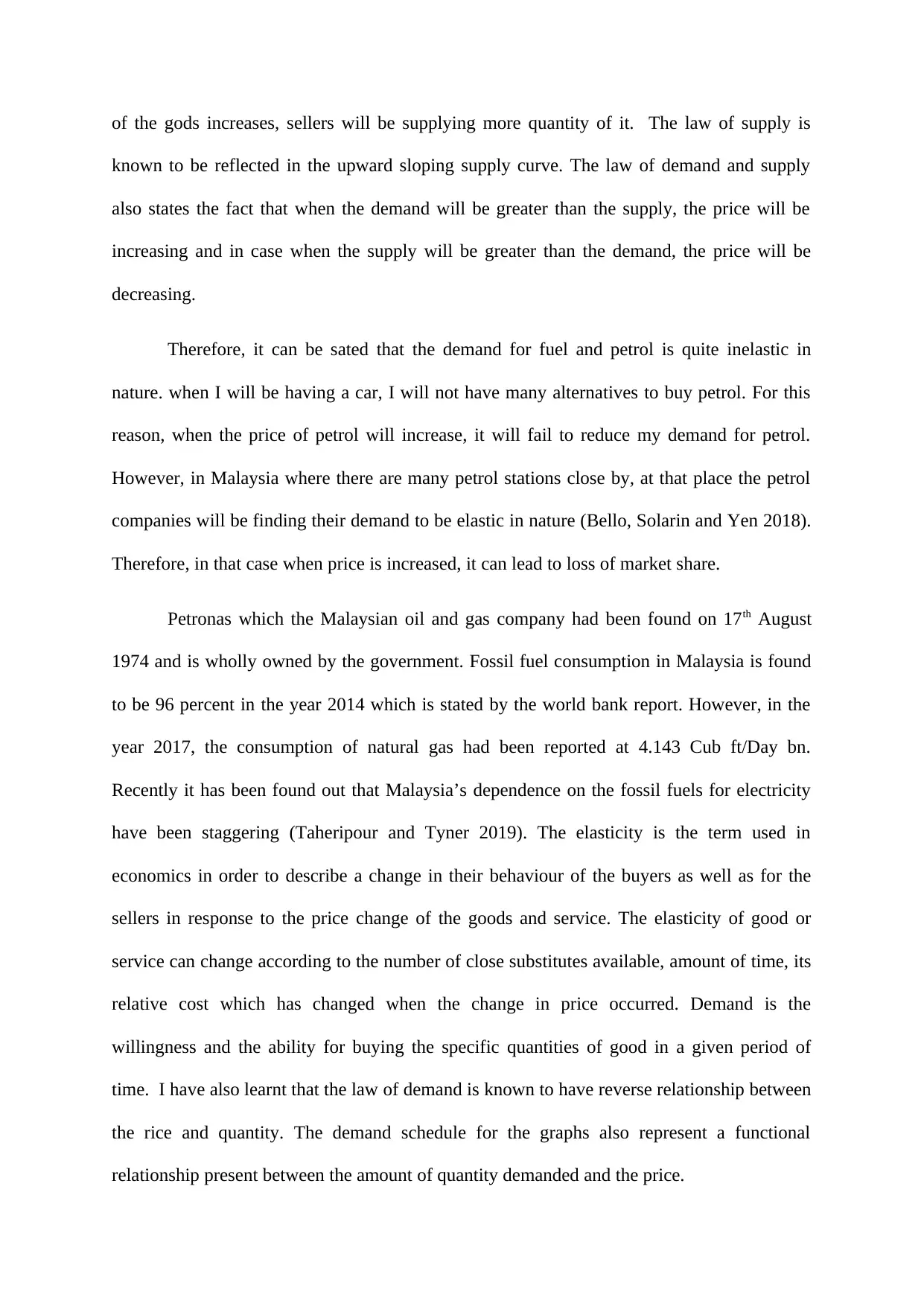
of the gods increases, sellers will be supplying more quantity of it. The law of supply is
known to be reflected in the upward sloping supply curve. The law of demand and supply
also states the fact that when the demand will be greater than the supply, the price will be
increasing and in case when the supply will be greater than the demand, the price will be
decreasing.
Therefore, it can be sated that the demand for fuel and petrol is quite inelastic in
nature. when I will be having a car, I will not have many alternatives to buy petrol. For this
reason, when the price of petrol will increase, it will fail to reduce my demand for petrol.
However, in Malaysia where there are many petrol stations close by, at that place the petrol
companies will be finding their demand to be elastic in nature (Bello, Solarin and Yen 2018).
Therefore, in that case when price is increased, it can lead to loss of market share.
Petronas which the Malaysian oil and gas company had been found on 17th August
1974 and is wholly owned by the government. Fossil fuel consumption in Malaysia is found
to be 96 percent in the year 2014 which is stated by the world bank report. However, in the
year 2017, the consumption of natural gas had been reported at 4.143 Cub ft/Day bn.
Recently it has been found out that Malaysia’s dependence on the fossil fuels for electricity
have been staggering (Taheripour and Tyner 2019). The elasticity is the term used in
economics in order to describe a change in their behaviour of the buyers as well as for the
sellers in response to the price change of the goods and service. The elasticity of good or
service can change according to the number of close substitutes available, amount of time, its
relative cost which has changed when the change in price occurred. Demand is the
willingness and the ability for buying the specific quantities of good in a given period of
time. I have also learnt that the law of demand is known to have reverse relationship between
the rice and quantity. The demand schedule for the graphs also represent a functional
relationship present between the amount of quantity demanded and the price.
known to be reflected in the upward sloping supply curve. The law of demand and supply
also states the fact that when the demand will be greater than the supply, the price will be
increasing and in case when the supply will be greater than the demand, the price will be
decreasing.
Therefore, it can be sated that the demand for fuel and petrol is quite inelastic in
nature. when I will be having a car, I will not have many alternatives to buy petrol. For this
reason, when the price of petrol will increase, it will fail to reduce my demand for petrol.
However, in Malaysia where there are many petrol stations close by, at that place the petrol
companies will be finding their demand to be elastic in nature (Bello, Solarin and Yen 2018).
Therefore, in that case when price is increased, it can lead to loss of market share.
Petronas which the Malaysian oil and gas company had been found on 17th August
1974 and is wholly owned by the government. Fossil fuel consumption in Malaysia is found
to be 96 percent in the year 2014 which is stated by the world bank report. However, in the
year 2017, the consumption of natural gas had been reported at 4.143 Cub ft/Day bn.
Recently it has been found out that Malaysia’s dependence on the fossil fuels for electricity
have been staggering (Taheripour and Tyner 2019). The elasticity is the term used in
economics in order to describe a change in their behaviour of the buyers as well as for the
sellers in response to the price change of the goods and service. The elasticity of good or
service can change according to the number of close substitutes available, amount of time, its
relative cost which has changed when the change in price occurred. Demand is the
willingness and the ability for buying the specific quantities of good in a given period of
time. I have also learnt that the law of demand is known to have reverse relationship between
the rice and quantity. The demand schedule for the graphs also represent a functional
relationship present between the amount of quantity demanded and the price.
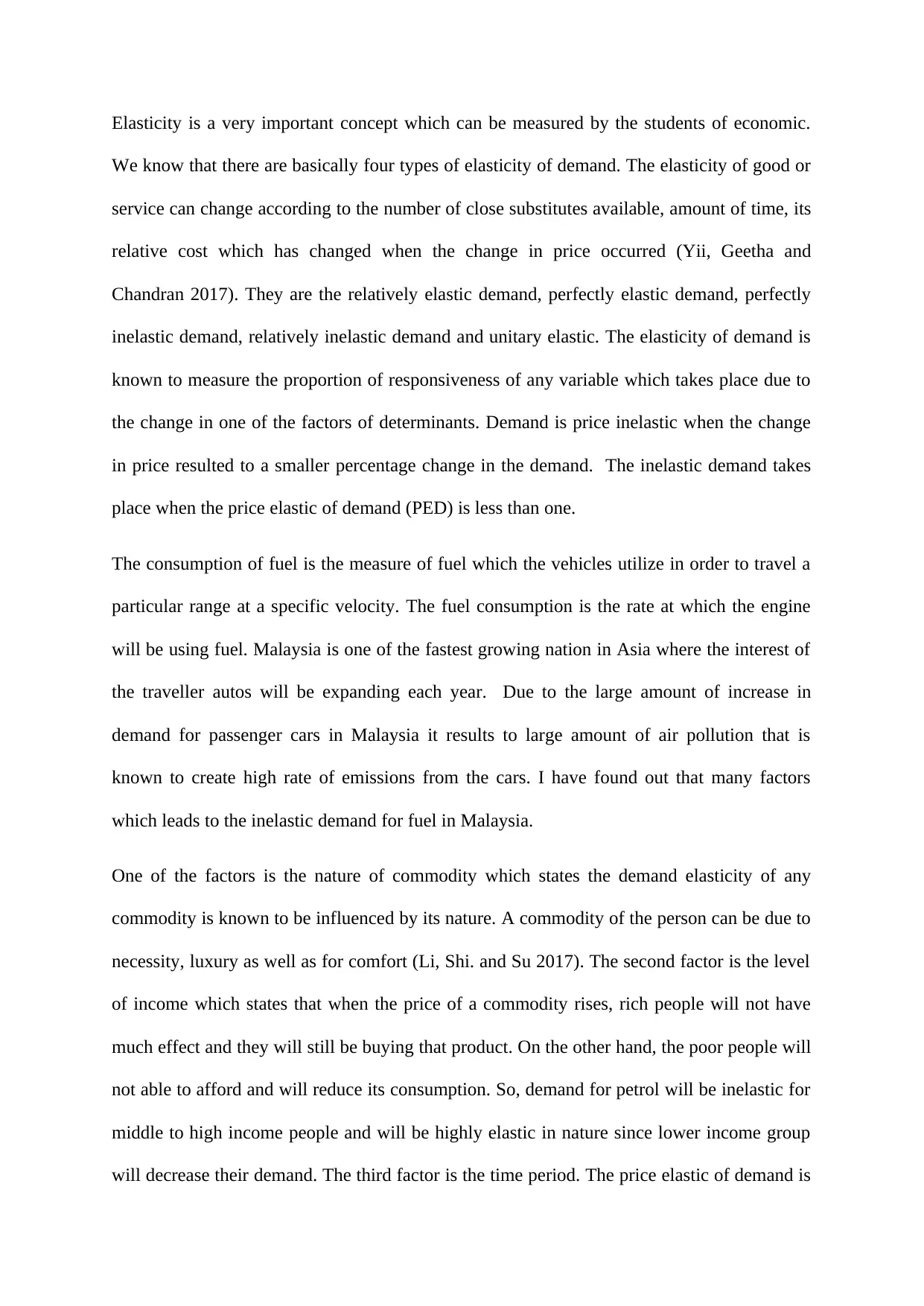
Elasticity is a very important concept which can be measured by the students of economic.
We know that there are basically four types of elasticity of demand. The elasticity of good or
service can change according to the number of close substitutes available, amount of time, its
relative cost which has changed when the change in price occurred (Yii, Geetha and
Chandran 2017). They are the relatively elastic demand, perfectly elastic demand, perfectly
inelastic demand, relatively inelastic demand and unitary elastic. The elasticity of demand is
known to measure the proportion of responsiveness of any variable which takes place due to
the change in one of the factors of determinants. Demand is price inelastic when the change
in price resulted to a smaller percentage change in the demand. The inelastic demand takes
place when the price elastic of demand (PED) is less than one.
The consumption of fuel is the measure of fuel which the vehicles utilize in order to travel a
particular range at a specific velocity. The fuel consumption is the rate at which the engine
will be using fuel. Malaysia is one of the fastest growing nation in Asia where the interest of
the traveller autos will be expanding each year. Due to the large amount of increase in
demand for passenger cars in Malaysia it results to large amount of air pollution that is
known to create high rate of emissions from the cars. I have found out that many factors
which leads to the inelastic demand for fuel in Malaysia.
One of the factors is the nature of commodity which states the demand elasticity of any
commodity is known to be influenced by its nature. A commodity of the person can be due to
necessity, luxury as well as for comfort (Li, Shi. and Su 2017). The second factor is the level
of income which states that when the price of a commodity rises, rich people will not have
much effect and they will still be buying that product. On the other hand, the poor people will
not able to afford and will reduce its consumption. So, demand for petrol will be inelastic for
middle to high income people and will be highly elastic in nature since lower income group
will decrease their demand. The third factor is the time period. The price elastic of demand is
We know that there are basically four types of elasticity of demand. The elasticity of good or
service can change according to the number of close substitutes available, amount of time, its
relative cost which has changed when the change in price occurred (Yii, Geetha and
Chandran 2017). They are the relatively elastic demand, perfectly elastic demand, perfectly
inelastic demand, relatively inelastic demand and unitary elastic. The elasticity of demand is
known to measure the proportion of responsiveness of any variable which takes place due to
the change in one of the factors of determinants. Demand is price inelastic when the change
in price resulted to a smaller percentage change in the demand. The inelastic demand takes
place when the price elastic of demand (PED) is less than one.
The consumption of fuel is the measure of fuel which the vehicles utilize in order to travel a
particular range at a specific velocity. The fuel consumption is the rate at which the engine
will be using fuel. Malaysia is one of the fastest growing nation in Asia where the interest of
the traveller autos will be expanding each year. Due to the large amount of increase in
demand for passenger cars in Malaysia it results to large amount of air pollution that is
known to create high rate of emissions from the cars. I have found out that many factors
which leads to the inelastic demand for fuel in Malaysia.
One of the factors is the nature of commodity which states the demand elasticity of any
commodity is known to be influenced by its nature. A commodity of the person can be due to
necessity, luxury as well as for comfort (Li, Shi. and Su 2017). The second factor is the level
of income which states that when the price of a commodity rises, rich people will not have
much effect and they will still be buying that product. On the other hand, the poor people will
not able to afford and will reduce its consumption. So, demand for petrol will be inelastic for
middle to high income people and will be highly elastic in nature since lower income group
will decrease their demand. The third factor is the time period. The price elastic of demand is
Secure Best Marks with AI Grader
Need help grading? Try our AI Grader for instant feedback on your assignments.
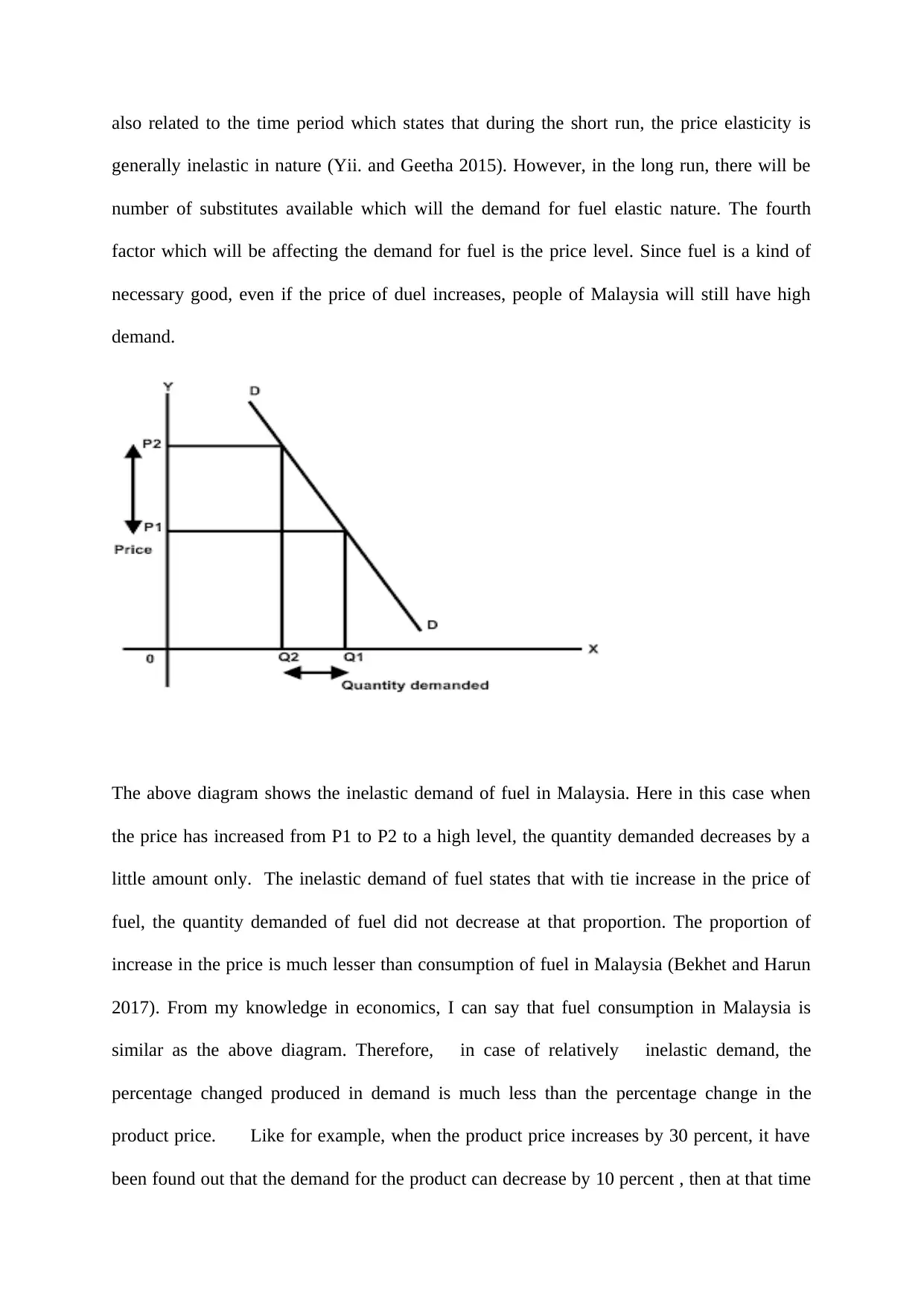
also related to the time period which states that during the short run, the price elasticity is
generally inelastic in nature (Yii. and Geetha 2015). However, in the long run, there will be
number of substitutes available which will the demand for fuel elastic nature. The fourth
factor which will be affecting the demand for fuel is the price level. Since fuel is a kind of
necessary good, even if the price of duel increases, people of Malaysia will still have high
demand.
The above diagram shows the inelastic demand of fuel in Malaysia. Here in this case when
the price has increased from P1 to P2 to a high level, the quantity demanded decreases by a
little amount only. The inelastic demand of fuel states that with tie increase in the price of
fuel, the quantity demanded of fuel did not decrease at that proportion. The proportion of
increase in the price is much lesser than consumption of fuel in Malaysia (Bekhet and Harun
2017). From my knowledge in economics, I can say that fuel consumption in Malaysia is
similar as the above diagram. Therefore, in case of relatively inelastic demand, the
percentage changed produced in demand is much less than the percentage change in the
product price. Like for example, when the product price increases by 30 percent, it have
been found out that the demand for the product can decrease by 10 percent , then at that time
generally inelastic in nature (Yii. and Geetha 2015). However, in the long run, there will be
number of substitutes available which will the demand for fuel elastic nature. The fourth
factor which will be affecting the demand for fuel is the price level. Since fuel is a kind of
necessary good, even if the price of duel increases, people of Malaysia will still have high
demand.
The above diagram shows the inelastic demand of fuel in Malaysia. Here in this case when
the price has increased from P1 to P2 to a high level, the quantity demanded decreases by a
little amount only. The inelastic demand of fuel states that with tie increase in the price of
fuel, the quantity demanded of fuel did not decrease at that proportion. The proportion of
increase in the price is much lesser than consumption of fuel in Malaysia (Bekhet and Harun
2017). From my knowledge in economics, I can say that fuel consumption in Malaysia is
similar as the above diagram. Therefore, in case of relatively inelastic demand, the
percentage changed produced in demand is much less than the percentage change in the
product price. Like for example, when the product price increases by 30 percent, it have
been found out that the demand for the product can decrease by 10 percent , then at that time

the demand is termed to be relatively inelastic demand. In case of inelastic demand, the value
ranges between zero to one (ep <1 ).
ranges between zero to one (ep <1 ).
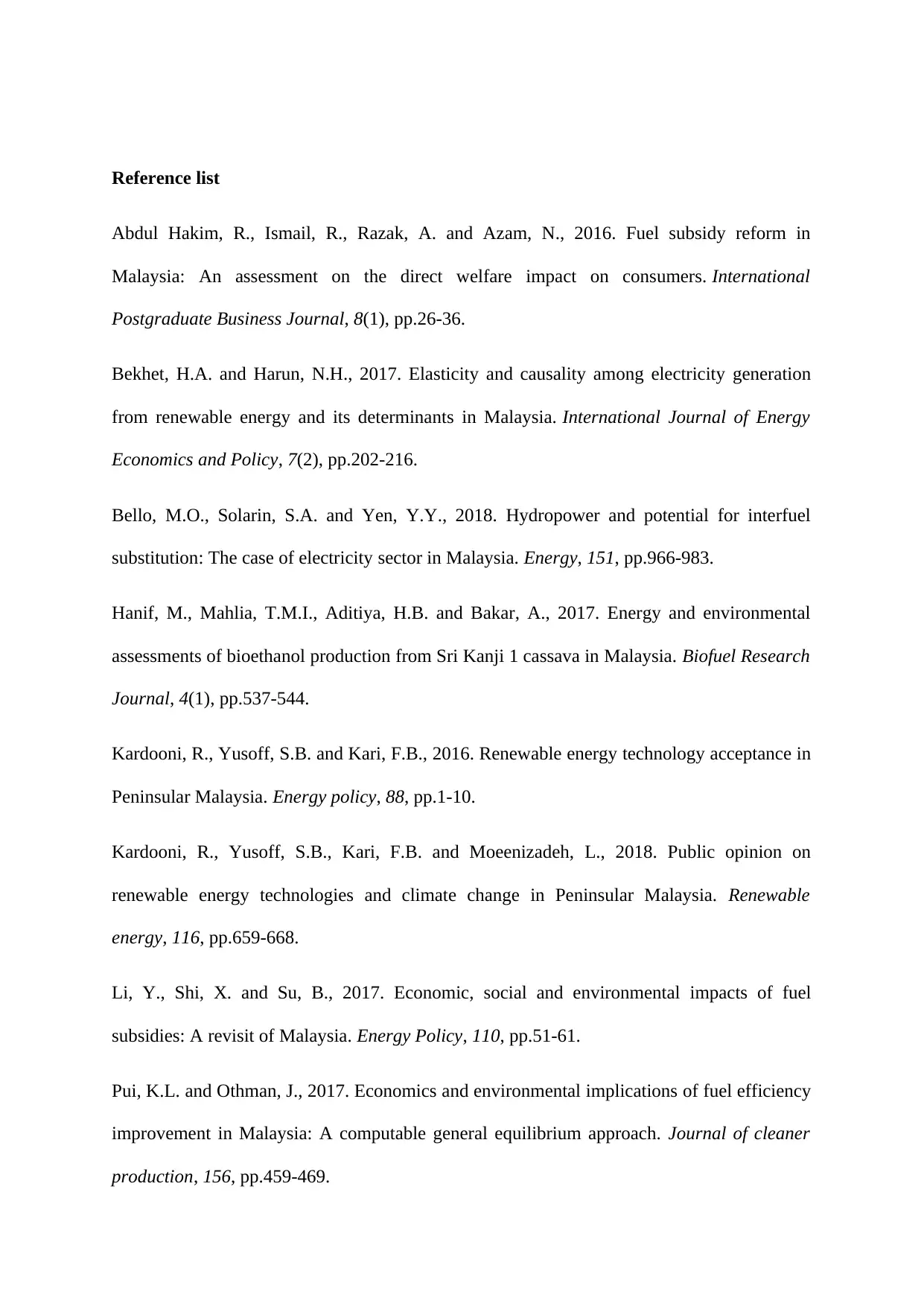
Reference list
Abdul Hakim, R., Ismail, R., Razak, A. and Azam, N., 2016. Fuel subsidy reform in
Malaysia: An assessment on the direct welfare impact on consumers. International
Postgraduate Business Journal, 8(1), pp.26-36.
Bekhet, H.A. and Harun, N.H., 2017. Elasticity and causality among electricity generation
from renewable energy and its determinants in Malaysia. International Journal of Energy
Economics and Policy, 7(2), pp.202-216.
Bello, M.O., Solarin, S.A. and Yen, Y.Y., 2018. Hydropower and potential for interfuel
substitution: The case of electricity sector in Malaysia. Energy, 151, pp.966-983.
Hanif, M., Mahlia, T.M.I., Aditiya, H.B. and Bakar, A., 2017. Energy and environmental
assessments of bioethanol production from Sri Kanji 1 cassava in Malaysia. Biofuel Research
Journal, 4(1), pp.537-544.
Kardooni, R., Yusoff, S.B. and Kari, F.B., 2016. Renewable energy technology acceptance in
Peninsular Malaysia. Energy policy, 88, pp.1-10.
Kardooni, R., Yusoff, S.B., Kari, F.B. and Moeenizadeh, L., 2018. Public opinion on
renewable energy technologies and climate change in Peninsular Malaysia. Renewable
energy, 116, pp.659-668.
Li, Y., Shi, X. and Su, B., 2017. Economic, social and environmental impacts of fuel
subsidies: A revisit of Malaysia. Energy Policy, 110, pp.51-61.
Pui, K.L. and Othman, J., 2017. Economics and environmental implications of fuel efficiency
improvement in Malaysia: A computable general equilibrium approach. Journal of cleaner
production, 156, pp.459-469.
Abdul Hakim, R., Ismail, R., Razak, A. and Azam, N., 2016. Fuel subsidy reform in
Malaysia: An assessment on the direct welfare impact on consumers. International
Postgraduate Business Journal, 8(1), pp.26-36.
Bekhet, H.A. and Harun, N.H., 2017. Elasticity and causality among electricity generation
from renewable energy and its determinants in Malaysia. International Journal of Energy
Economics and Policy, 7(2), pp.202-216.
Bello, M.O., Solarin, S.A. and Yen, Y.Y., 2018. Hydropower and potential for interfuel
substitution: The case of electricity sector in Malaysia. Energy, 151, pp.966-983.
Hanif, M., Mahlia, T.M.I., Aditiya, H.B. and Bakar, A., 2017. Energy and environmental
assessments of bioethanol production from Sri Kanji 1 cassava in Malaysia. Biofuel Research
Journal, 4(1), pp.537-544.
Kardooni, R., Yusoff, S.B. and Kari, F.B., 2016. Renewable energy technology acceptance in
Peninsular Malaysia. Energy policy, 88, pp.1-10.
Kardooni, R., Yusoff, S.B., Kari, F.B. and Moeenizadeh, L., 2018. Public opinion on
renewable energy technologies and climate change in Peninsular Malaysia. Renewable
energy, 116, pp.659-668.
Li, Y., Shi, X. and Su, B., 2017. Economic, social and environmental impacts of fuel
subsidies: A revisit of Malaysia. Energy Policy, 110, pp.51-61.
Pui, K.L. and Othman, J., 2017. Economics and environmental implications of fuel efficiency
improvement in Malaysia: A computable general equilibrium approach. Journal of cleaner
production, 156, pp.459-469.
Paraphrase This Document
Need a fresh take? Get an instant paraphrase of this document with our AI Paraphraser
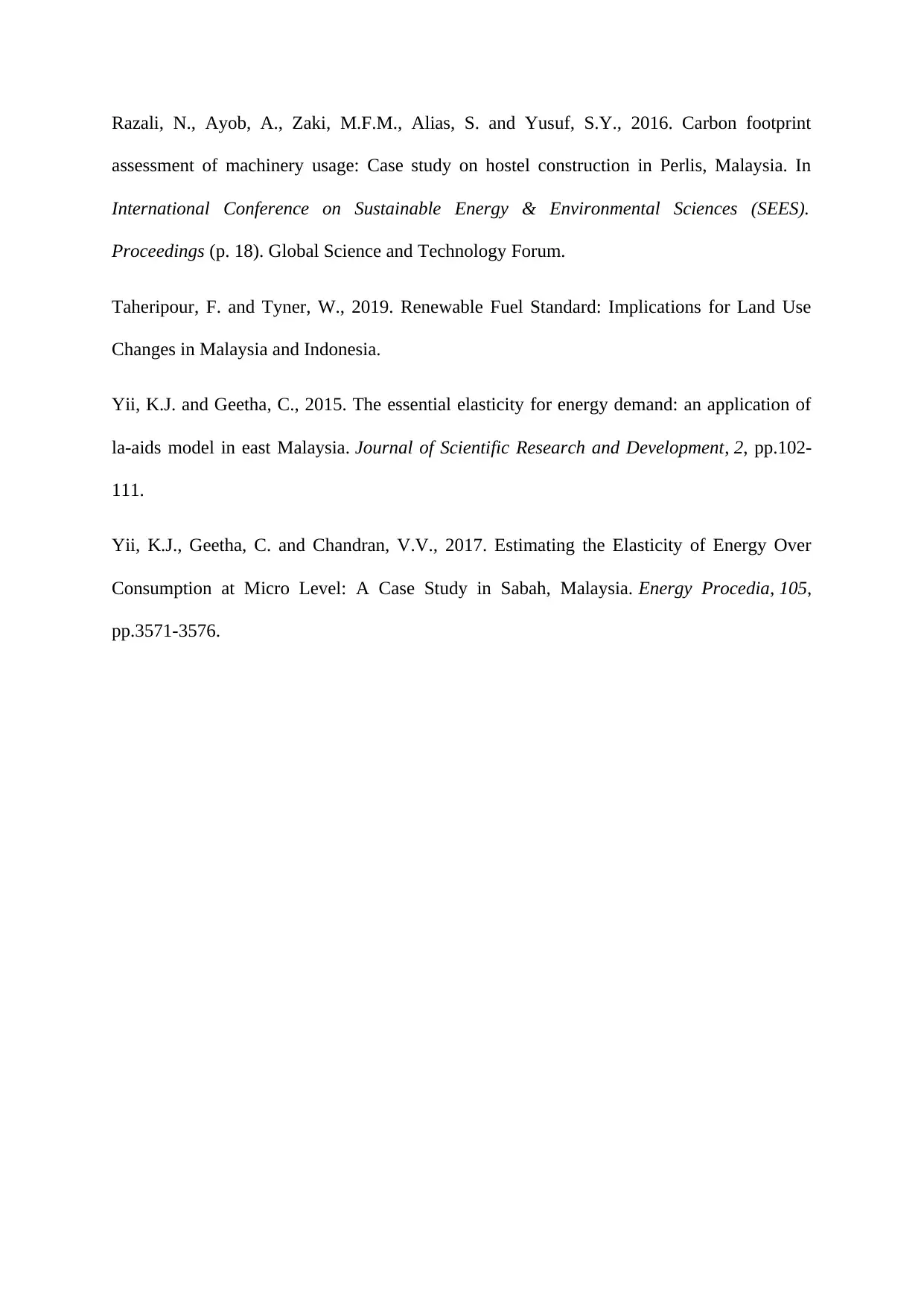
Razali, N., Ayob, A., Zaki, M.F.M., Alias, S. and Yusuf, S.Y., 2016. Carbon footprint
assessment of machinery usage: Case study on hostel construction in Perlis, Malaysia. In
International Conference on Sustainable Energy & Environmental Sciences (SEES).
Proceedings (p. 18). Global Science and Technology Forum.
Taheripour, F. and Tyner, W., 2019. Renewable Fuel Standard: Implications for Land Use
Changes in Malaysia and Indonesia.
Yii, K.J. and Geetha, C., 2015. The essential elasticity for energy demand: an application of
la-aids model in east Malaysia. Journal of Scientific Research and Development, 2, pp.102-
111.
Yii, K.J., Geetha, C. and Chandran, V.V., 2017. Estimating the Elasticity of Energy Over
Consumption at Micro Level: A Case Study in Sabah, Malaysia. Energy Procedia, 105,
pp.3571-3576.
assessment of machinery usage: Case study on hostel construction in Perlis, Malaysia. In
International Conference on Sustainable Energy & Environmental Sciences (SEES).
Proceedings (p. 18). Global Science and Technology Forum.
Taheripour, F. and Tyner, W., 2019. Renewable Fuel Standard: Implications for Land Use
Changes in Malaysia and Indonesia.
Yii, K.J. and Geetha, C., 2015. The essential elasticity for energy demand: an application of
la-aids model in east Malaysia. Journal of Scientific Research and Development, 2, pp.102-
111.
Yii, K.J., Geetha, C. and Chandran, V.V., 2017. Estimating the Elasticity of Energy Over
Consumption at Micro Level: A Case Study in Sabah, Malaysia. Energy Procedia, 105,
pp.3571-3576.
1 out of 8
Related Documents
Your All-in-One AI-Powered Toolkit for Academic Success.
+13062052269
info@desklib.com
Available 24*7 on WhatsApp / Email
![[object Object]](/_next/static/media/star-bottom.7253800d.svg)
Unlock your academic potential
© 2024 | Zucol Services PVT LTD | All rights reserved.




